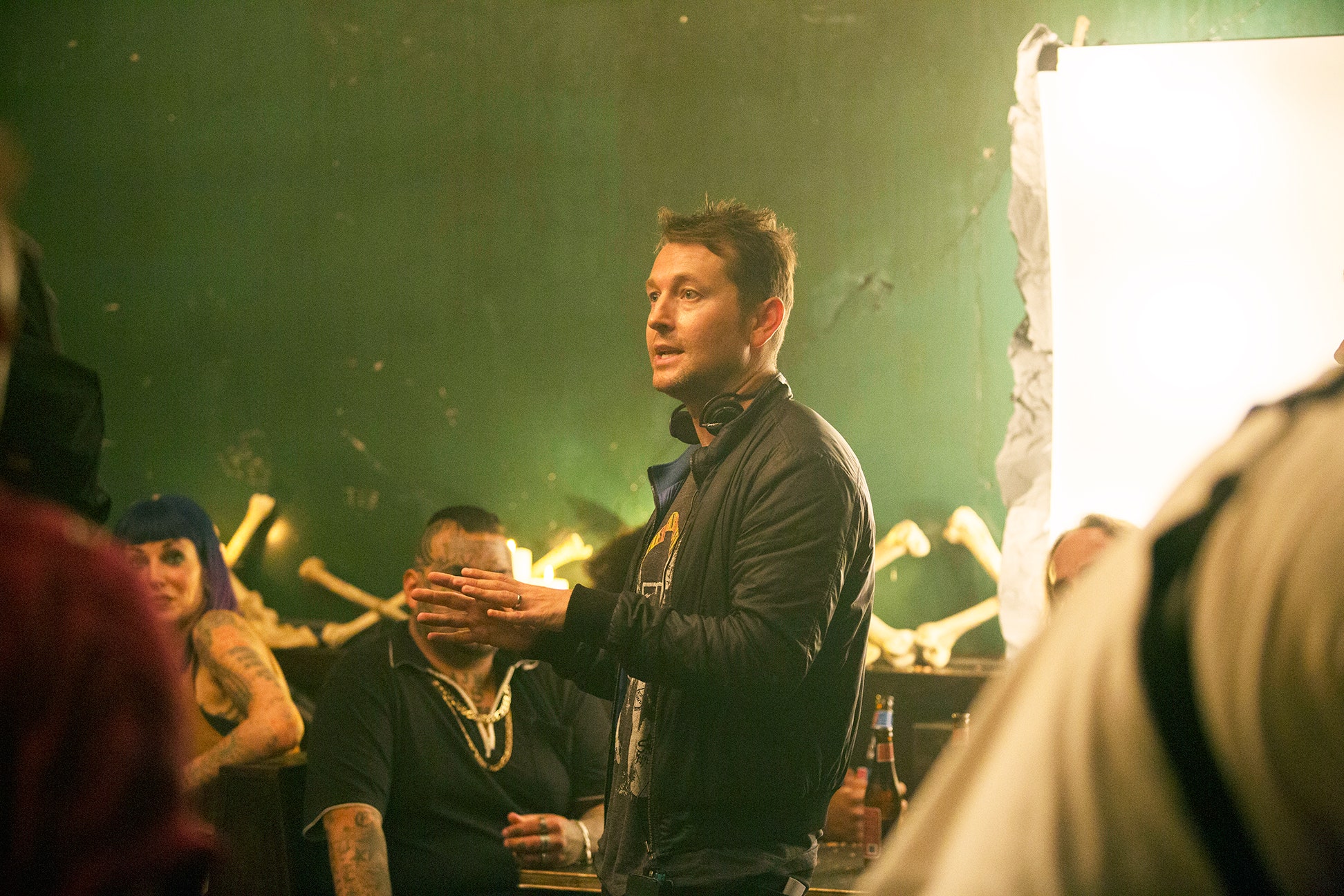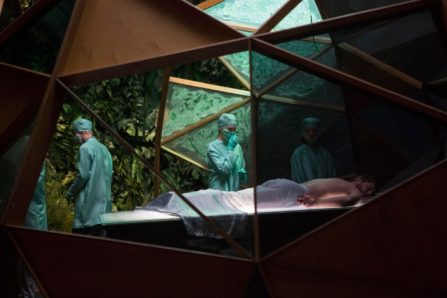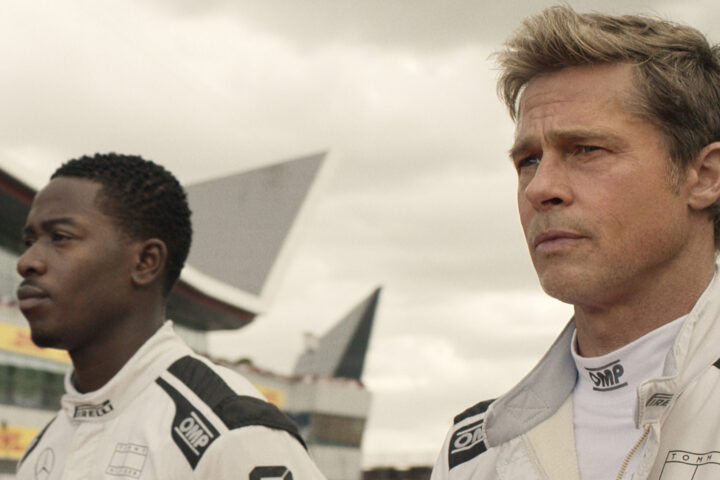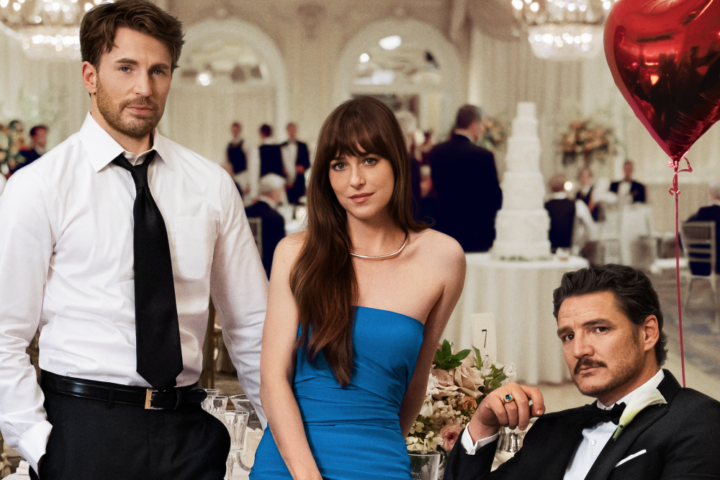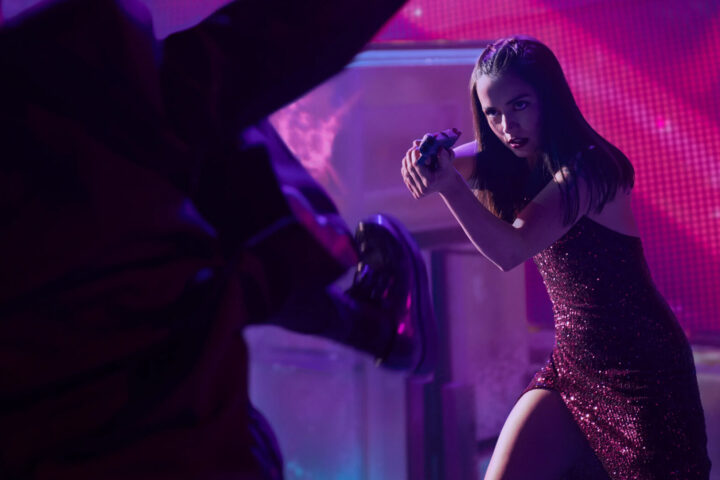Leigh Whannell’s Upgrade, the surprise of the commercial moviegoing year, is a sleeper of a picture that outpaces the season’s big Hollywood effects movies with ideas and craft and moderate scale, a cautionary sci-fi actioner about AI, vengeance and what we are losing in our increasing dependence on technology.
Fashioned as a loving mash up of Verhoeven, Cronenberg, Cameron, Crichton and a touch of Clarke, Upgrade stars Logan Marshall-Green as a car mechanic out to avenge his wife’s murder and whose quadriplegic body fuses with—naturally—a supercomputer that wants to be human. His increasingly sentient AI implant, appropriately named STEM, controls his body. It also wants his mind.
Whannell, who writes, directs and sometimes finds time to act, is the brainchild behind both the Saw and Insidious franchises, is an avid genre film devotee who knows his way around dressing up thrills with wit and style; his movies clever puzzles often upending existing genre tropes with novel ideas (like Insidious’ nether-realm The Further). In Upgrade, he uses sci-fi to muse on where we might be headed, and the result is thought-provoking popcorn of a high order. ,
I recently caught up with Leigh Whannell to chat about Upgrade’s novel near-future premise and the challenges and liberations of making a small-scale picture with such big ideas. And as in past chats, we took a moment to indulge in our mutual reverie for 80s nostalgia, much of which informs his terrific new movie.
One of the things I really appreciated about this movie is that it’s very “now” while paying homage to an entire era of movies like Robocop, The Terminator and others. There is even a little 2001: A Space Odyssey at one point. It operates within genre but cleverly so and with great bursts of imagination.
I wish all interviews started like this! One of the most beautiful things about making a movie is when people recognize what you were going for without telling them! Those movies you mentioned were definite influences.
For me personally, I love the idea of telling a genre story that hits all the beats and then asking myself, “What are you going to bring to it that hasn’t been seen? What will your contribution be to this canon? We have all seen fight scenes and AI before, so what can you bring?”
And I always find it more interesting when someone creative like David Lynch, who has a wild mind, operates within the context of story and genre. You watch Blue Velvet and it’s this great mystery, and then Twin Peaks has the quirkiness and fun that come through even though it’s a mystery.
What is the piece of this movie that so lovingly harkens back to that particular era.
If you are talking about the era of practical driven special effects films like Robocop and The Terminator…
And Videodrome, which I also felt here.
Oh, absolutely! You know what it is? It’s a few things. Foremost, I love those movies and there is a lot of nostalgia attached to this. I have so much nostalgia about going to video stores and these movies that I loved growing up, even I know that nostalgia is often linked to who you were back then rather than the actual movies. For example, there have been plenty of movies I loved as a kid that I watch know and say, “Well, that one didn’t really hold up!”
Yes, it’s the idea of it filtered through the lens of adolescence that’s often better than the film.
Yes, the idea of nostalgia is often better than the movie! But then there are the ones that really do hold up. You were talking about The Terminator, Robocop, Videodrome and then also The Thing. The Thing is flawless to this day. It even holds up under HD scrutiny! There is one practical effect that falls apart which is the matte painting. But other than that…
So beyond the nostalgia factor, those movies you talked about are a great inspiration because they were made before the advent of CG and they had to work within a box. If you look at The Terminator, it’s really lean and mean. And they are very judicious about the way that they dole out the elements of sci-fi; they had to pick and choose. And I knew that is what I was going to have to do with this movie, so I watched The Terminator religiously and I studied how it gave you pieces of the future and the tech. It was a great bible.
And I think lastly, those movies were more interesting to me because they had to get more inventive since they could not do everything. And that is what I love. I mean, It is fine to have a movie where a portal opens up in the sky and an army of robots comes down to destroy a city. But what I really love it when the story is humanized and you say, “It’s cop and now he’s trying to find his family.”
Yes, well those movies had ideas about science also. What you just described—the over-the-top effects movies—typically do not. I think that has gotten lost in what we call sci-fi movies today and it’s in The Terminator and also in this movie. But it’s also contemporary in terms of its cautionary depiction of AI advances, which is on a lot of minds today.
Yes. I was trying to contemporize the AI thing to modern society because obviously AI has been a thing in movies for a long time going back to HAL and even before that. But what I was trying to do was milk anxieties out of this Alexa-driven world. My daughter thinks it’s perfectly normal to walk into the kitchen and say, “Alexa, play the Frozen soundtrack.” As far as she is concerned, Alexa is another person in the family. So I tried to infuse the film with that.
Let’s talk about the look of the film. Certain moments are gorgeous, like the scene where Logan Marshall-Green is in the backroom of the bar, on top of the gentleman who is on the floor. The colors in that scene and way they light the faces—blue, red and more—is lovely. And then the moment where he goes to the fourth floor of the hacker’s headquarters and there’s a long shot of the hallway and some sort of glowing shards are on the floor, and there’s green on the walls. The look of it was very slick and obviously you had to accomplish this with a modest budget.
Thanks for saying this. Yes, we had to be creative! I think the way you do it is in steps. You have your script and an idea in your mind of what you want it to look like. Then choosing the cinematographer is obviously a huge part of it. Stefan Duscio—I knew he was really talented as an up-and-comer. At our budget you can only get the up and comers! You can’t get the already theres! I knew Stefan was up to the challenge and so we used many discussions as excuses to watch movies. We would be sitting in the office and say, “You know that shot in Seven where it’s grimy, but it still looks like a Renaissance painting? We should watch Seven!” And the producer would come in and say, “Are you guys working or just watching a movie?”
And then the real world meets your plans. That shot you talked about down the hallway with the glow sticks was a scenario- I think it is best to start with what is practical and lives in the story. Don’t put the cart before the horse and say, “What looks beautiful? We will make the story fit that.” So with that one it was like, “Okay, we have got this building where these hackers live that is off-the-grid.” We worked out that they would suck power from the city’s energy grid. So now we had just made a production choice because we had to lay hundreds of cables through windows. I don’t know if you have ever been to Bangkok or Southeast Asia, but in the cities they have these incredible jungles of cables. They almost look like vines. God knows what happens if your power goes out and you have to figure it out. So I brought photos of that and said I wanted it.
And then we started thinking, “If they don’t have lights, what do they use?” I said, “What if we used glow sticks—those things you snap?” You see what I am saying? Each story decision informs a production design decision and that is always the best way to go because you can back everything up. If you asked me, “Why are there glow sticks? Is that just supposed to be cool looking?” I would say, “No, the hackers in the building use those to fix things. They use them as lights.” So that is really the answer to it—use the story to tell you what the film looks like.
I thought the score was hypnotic. It reminded me of Brad Fiedel or Howard Shore maybe, and it’s used sparingly throughout the film so I was always waiting to hear it again. I also loved the production design as well at the end of the film as they go down beneath ground and the tree is in the middle of that room; just gorgeously done.
Yes, thank you!
Let’s talk about Logan Marshall-Green and Betty Gabriel, who are both very likable here. It was really good to see her, especially, front and center.
She is brilliant. She is one of those actors who is so well-trained. She is from Juilliard and doesn’t carry the role with her. She can hang out with you and be joking. If you call action, two seconds later she is in it! It is a magic trick. And some actors need to sit in the corner for two hours and stew, which is fine too—whatever gets the role done. But Betty is just a delight.
And Logan is this untapped resource. I saw him in The Invitation, which I loved, and I could not stop thinking about that film. When we started casting, it just felt right because in that film he carries all this grief. He turned out to be a godsend because he threw himself into the physical aspects. It wasn’t until later when I finished the movie that I realized how dead in the water we would have been if we had cast an actor who wasn’t physically capable of pulling that off. We just got so lucky that he was able to do this stuff that not everyone can do.
But what’s great about that is that he is not- in Prometheus I suppose he was a little more bulked up, but here it’s effective because he looks a bit more like an average guy.
I loved mapping out the physicality of him because we started the movie with him really hunched and with bad posture. Even when he walks he is sort of making himself smaller, and also when he has lost his confidence. He goes through the physicality of the paralysis and worked with a quadriplegic guy to get that, and then with STEM his posture is perfect. So hopefully, at the end of the movie you have this map of the physicality changing. And actually, Logan said he never knew how poor his posture was until he did this movie because he had to constantly stand up straight! I’m a writer and spend my whole life like this (hunches over).
What is the best part about your job?
I think the best part is being excited to do the thing that you get paid for; when you combine your hobby and your job. A lot of people in the world are like, “I am going to the office and I do that to support my fishing hobby. That is where I put my joy in life—it’s my boat and I’m fixing it up.” You know? But to be able to combine those things in life is such a rare gift. Because if I wasn’t in this business and still lived in Australia and was teaching high school English, I would watch movies and think about them in my spare time. So now I have just cut out the middle man and that’s the best thing about it. You justify your obsession by saying, “Hey, this is my job!” Every movie I watch is informing me about some choice. It’s great. It’s so fun. So yeah, that is a good question but that’s it.
The last time we met here we debated Fulci and Argento.
I remember being right here in this room! Oh and of course we have the Suspiria remake around the corner.
Did you see the stills yet?
I did see the one, yes!
And then they shared a single scene at Cinemacon which was supposed to be really intense.
I heard about that! I’m bummed I didn’t see it! Then I read who the director was and I was like, “Whoa. What an interesting choice for another film.”
Have you seen I Am Love, which he made several years ago?
With Tilda Swinton? Not yet.
Yes, it has to be one of the most beautiful movies of all time. One thing we know is that the aesthetic of his Suspiria is going to be high-art.
I know! And you know that it is going to be thoughtful like Call Me By Your Name and I am assuming I am Love is also that thoughtful. It’s so hard to capture mood in a film and I felt at the end of Call Me By Your Name that I had spent a summer in Italy. The sounds and smells—I was there. Something that abstract is really tough to film.
Really terrific catching up today.
Yes! Great seeing you again.
